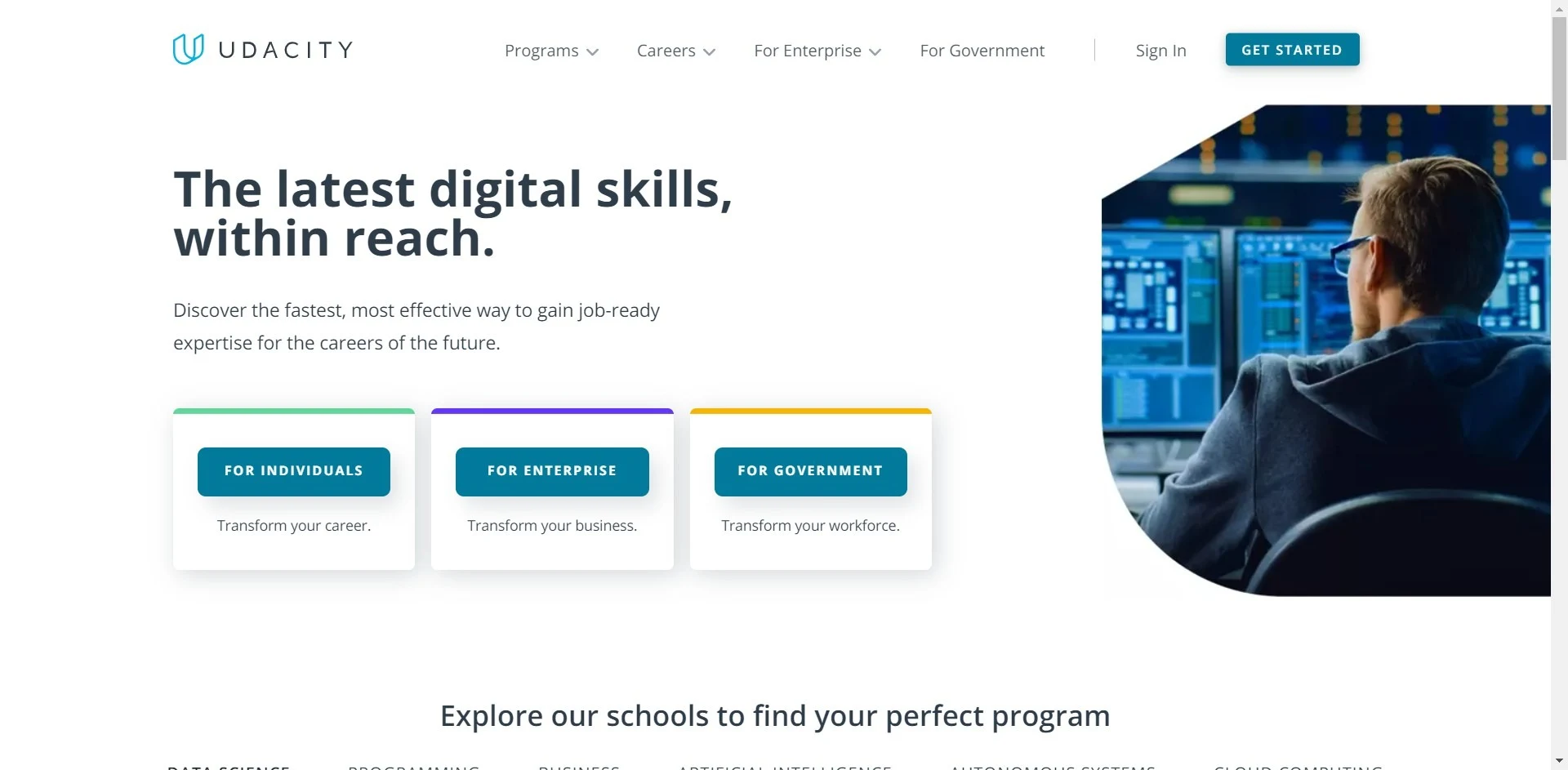- Best EdX Criminology Courses Guide - August 16, 2022
- Best EdX Design Courses That Could Help Jumpstart Your Career - August 16, 2022
- EdX vs Pluralsight - August 16, 2022
If you’ve ever considered taking online courses for an in-demand science or tech field but aren’t sure in what, you might want to consider data science courses. And data science courses, from Python and SQL to predictive analytics and machine learning are being offered more and more through online learning platforms like Dataquest and Udacity.
According to data compiled by LinkedIn, Data Science has enjoyed a job growth of 650%, while the U.S. The Bureau of Statistics estimates that by 2026 the United States could see as many as 11.5 million new jobs in Data Science.
LinkedIn also found that Data Science salaries in several areas are generous, with machine learning engineers, data scientists, and full-stack engineers all earning an average salary of over $100K per year, not including benefits.
While Udacity doesn't have the widest selection, the degrees they DO offer are robust, industry recognized "nano" degree programs (mostly concentrated in TECH careers). If you have the choice - and are looking for recognized credentials - Udacity is the more industry specific pick.
Of course, online courses don’t promise a career or landing a job. What online learning platforms like Dataquest and Udacity can do is introduce you to an emerging field, supplement your knowledge, and help you focus on your future education or career plans.
But even if you’re settled on learning data science courses, it’s important to select the right learning platform. In this article, I’ll review Dataquest vs Udacity and show how they compare so you can decide which learning platform is right for you.
The Main Differences Between Dataquest vs Udacity
The Main Differences Between Dataquest vs Udacity are:
- Dataquest offers courses in coding and basic Data Science, whereas Udacity offers these courses, more advanced offerings, and courses in outside fields
- Dataquest costs $25 to $50 for access to all courses, whereas Udacity offers access to some free courses and one full course at a time for $399 a month
- Dataquest teaches through mostly interactive problems and text-based learning, with some projects, whereas Udacity includes video lectures and interviews as well as small and capstone projects
What are Data Science Courses?

Data science is a rather expansive field that combines statistics, business courses, but also machine learning, and countless tasks dealing with algorithms. For this reason, taking data science courses is a rather general statement: the field is wide and rich with different fields of study, as well as careers.
Processes within Data Science
In the broader scope of the field, you’ll take on a series of processes that allow you to access, work with, and manipulate data in a meaningful way. These five stages, as defined by the University of Berkley, explain the sorts of general topics and activities that you’ll undertake in your courses.
Capture
In this stage, you’re working to acquire data. This stage includes the acquisition of data, entering data, and extracting data. You may also deal with signal reception: that is, capturing data from specific devices.
Maintain
In this stage, you’ll work with the initial organization and processing of data. This may include data warehousing, data cleansing, and data processing, as well as data architecture.
Process
In the process stage of data science, you’ll be most concerned with dating mining, as well as modeling, clustering, classification, and summarizing.
Analyze
In analyzing data, you’ll be tasked with predictive analysis, linear regression, text mining, and even some qualitative analysis.
Communicate
In the communication stage, the main tasks include communicating the data that has been organized and analyzed. This may come in the form of data reporting, data visualization, and decision making, as well as business intelligence.
Careers within Data Science
If you’re interested in Data Science, the good news is that there are many ways you can take your further education or career path. Though there are many careers within this expansive field, some of the most notable things you can do with this course of study include:
Machine Learning Engineer
Machine learning engineers work towards software development solutions, by designing systems and algorithms, as well as testing for performance. Practical implementations include creating, maintaining, and updating search engines, email filters, and algorithms for social media platforms.
Machine Learning Scientist
In this role, one is tasked with conducting research for new algorithms and finding ways they can be adopted, making use of deep learning, supervised, and unsupervised strategies. They are sometimes referred to as simply “Research Scientists.”
Data Scientist and Data Analyst
A data scientist organizes and makes sense of data for a variety of businesses. The technical end of data analysts, this career involves working with and categorizing large data sets for practical purposes. A data analyst, then, is tasked with performing an analysis of data, using A/B testing and other means, as well as tracking analytics.
Infrastructure and Enterprise Architects
Both infrastructure and enterprise architects work closely with businesses to embody the business’ purpose and mission. An enterprise architect specifically works to make technology work alongside a business’ goals and objectives, designing systems to work with these.
Infrastructure architects, on the other hand, are concerned with the implementation of new software and cloud services to meet requirements and align with the business’ needs.
Is Dataquest or Udacity the better for data science?
Since Dataquest caters to Data Science especially, and Udacity has many courses in this area, my main comparison will concern both the content of data science courses, as well as the overall value and experience.
Please do keep in mind the pros and cons of online learning platforms before you enroll in any course. Online courses are great for shoring up skills, helping you learn on your own schedule, and they do cost less than traditional courses from colleges. That said, they are not the equivalent to a college degree if they are an open-source platform– that is, without admission standards and do not grant a degree.
But with that in mind, here’s what you need to know about how Dataquest vs Udacity compares.
What is the main purpose of Dataquest vs Udacity?
Both Dataquest and Udacity focus on business/ tech fields– though they are heavily stilted towards areas of study pertaining to programming and data science (interested in general courses? Read this guide to the best online business courses).
Dataquest

Dataquest promotes itself as a platform where you can learn the essential skills to “land your first data scientist job.” Emphasizing the open enrollment nature of their platform and accessibility to all, they also ensure that “no experience is required” to take a course. I also noticed their emphasis on interactive classes, insisting that one learns coding best by actually doing coding, vs just listening to lectures about coding.
Udacity
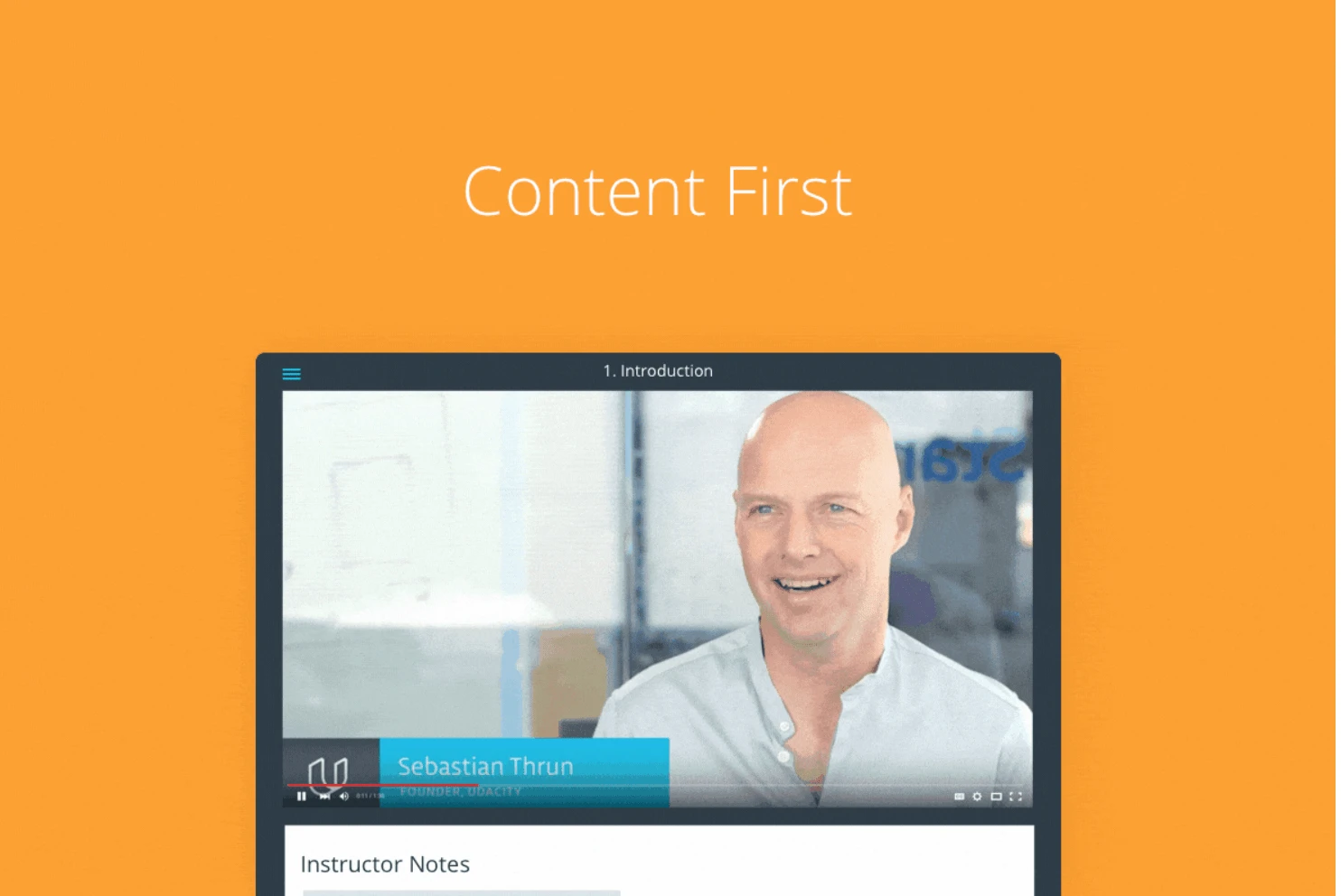
Udacity, meanwhile, takes a broader angle and promises less. Affirming its leadership within technology and business education for all, the focus is not so much on landing a job but on helping one achieve “lifelong learning” in a flexible and interactive learning environment, with a focus on student success and engagement.
My Takeaway
It’s notable that both Udacity and Dataquest openly advertise interactive learning– which, I presume, is to distance themselves from competitors that offer video-only lectures.
That said, while Udacity may sound vaguer in its outcomes, I prefer their messaging. Dataquest may very well teach you key skills, and it’s not going so far to promise a job, but they’re edging close to misleading messaging.
How much does Dataquest vs Udacity cost?
Affordability is a huge draw for most open-source online learning platforms, whether you’re taking photography classes or hoping to learn a new language. Whether you’re hoping to take courses for fun or even advance your career, there’s no doubt that open source platforms are typically more cost-effective– both there’s a big difference between Dataquest and Udacity.
Dataquest
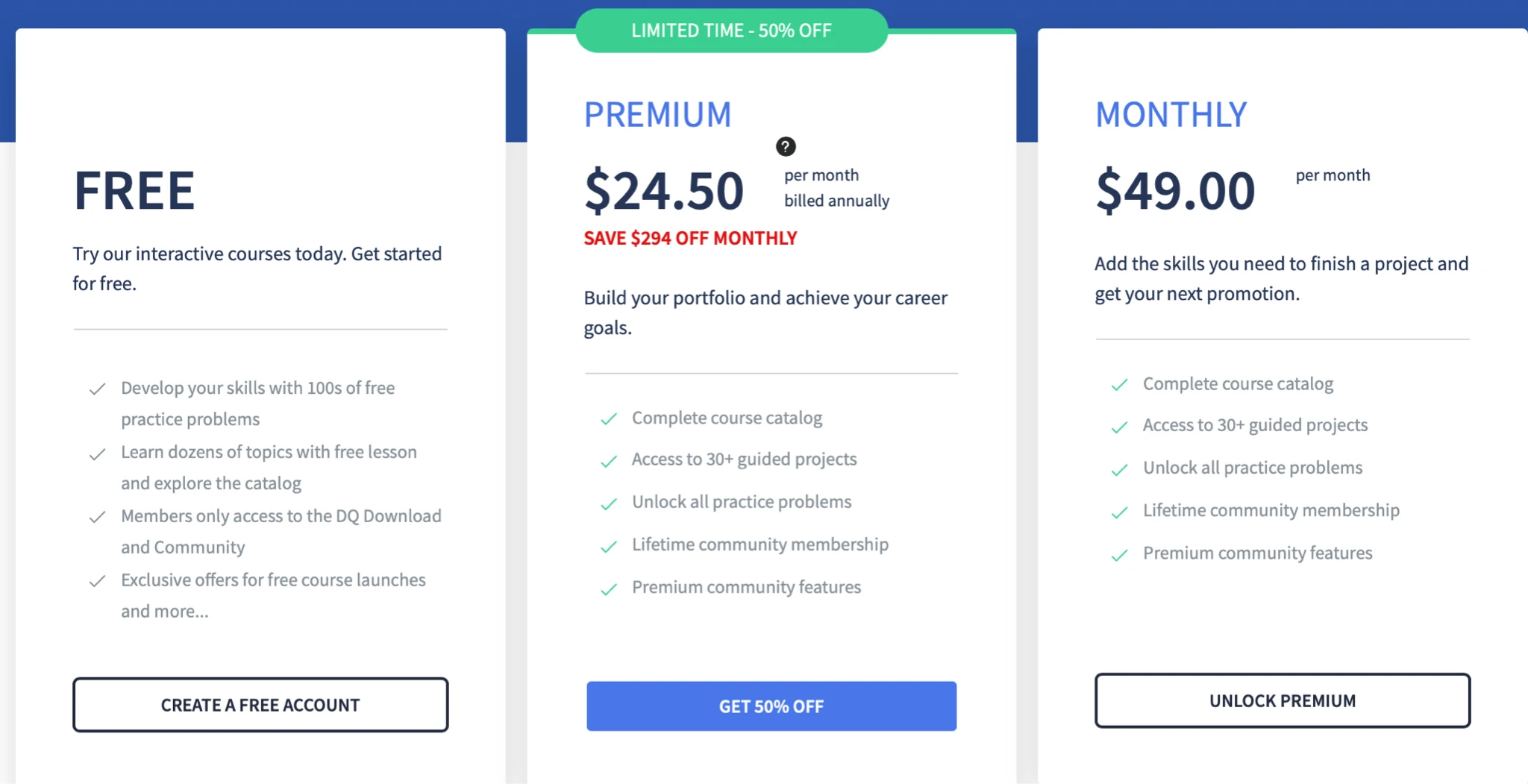
Dataquest offers three plans, all of which apply monthly. With these plans, you can select the course of your choice, though some plans have certain limitations. In other words, you’ll pay a monthly fee for access to the platform vs for specific courses.
- Free Plan: This plan is free of cost but doesn’t allow you to enroll in a full course. With the free plan, you’ll have access to 100’s of practice problems, and also have access to some community forums. While there are occasional free courses, you’ll want to have access to the main content. I recommend this for anyone on the fence about Dataquest who wants an introduction before fully committing, but it’s not going to provide a nuanced experience.
- Premium: This plan, which is currently offering 50% off and is priced at $25/ month, allows access to all courses, as well as over thirty hands-on projects, all practice problems, and special community features, including a community member. This is currently the best overall value.
- Monthly: At the typical price, the monthly plan costs $50/ month and includes all of the features of premium. It’s unclear how long the special pricing on Premium will last.
Udacity
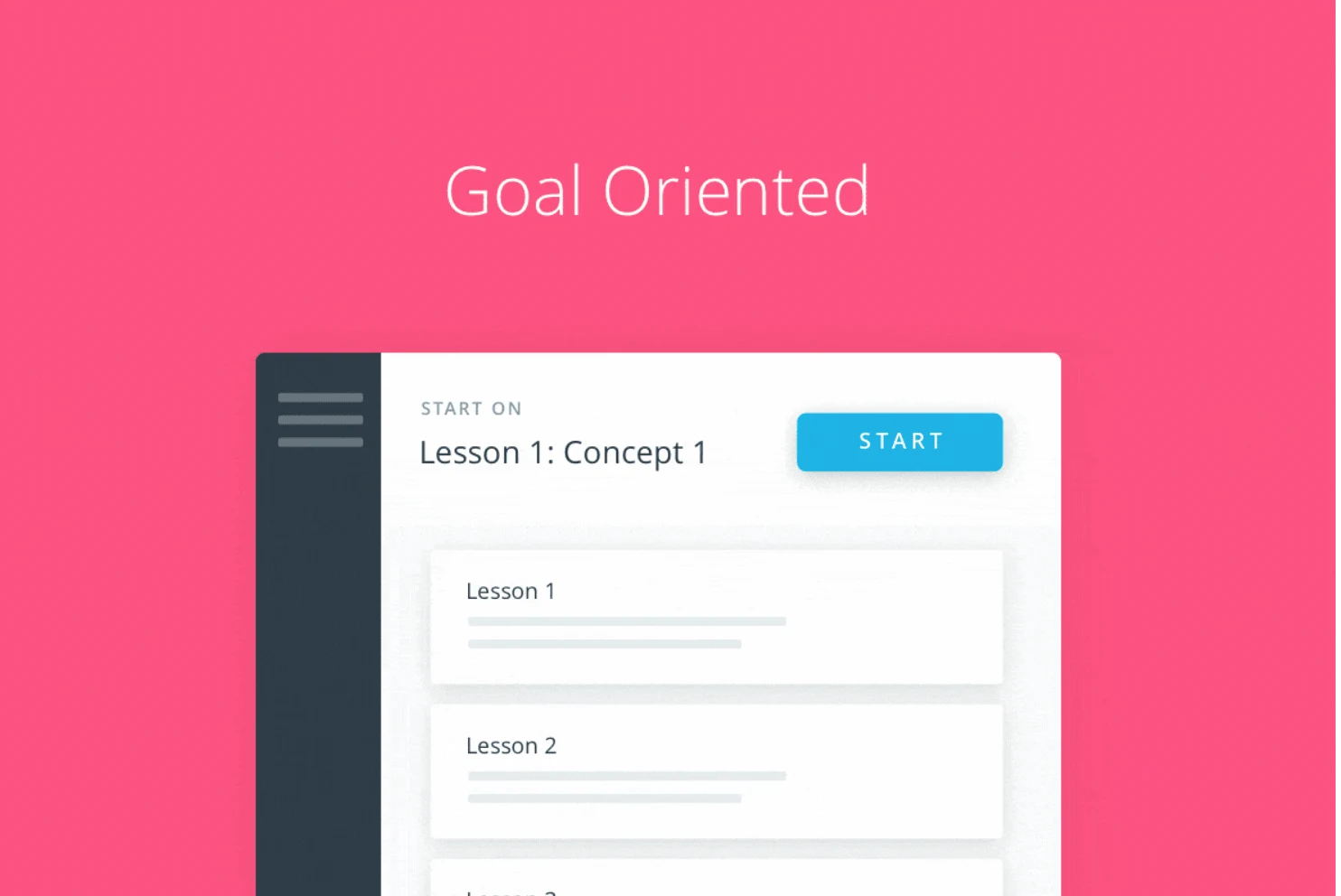
Udacity is notably more expensive than Dataquest, and pricing works differently. Rather than paying a monthly premium towards access to all courses, your monthly premium goes towards one course in which you enroll.
That is, the monthly cost of $399 for most courses will provide access to only that course. Courses vary in length and can take anywhere from a few weeks to a few months to complete, meaning you’ll easily be paying a few hundred to a few thousand for a full course.
My Takeaway
There’s no doubt that Dataquest is far cheaper, and would fit far more budgets than Udacity. For a full comparison, even on the most expensive plan, Dataquest will cost you $600 for the year–less than two months will cost you on Udacity. Considering that Udacity courses often take two to four months to complete, you can expect to invest at least several hundred dollars in Udacity.
What courses are offered on Udacity vs Dataquest?
Course offerings are quite different for Udacity vs Dataquest. While both platforms do focus on courses related to Data Science, there are simply far more courses, and far more variety offered on Udacity vs Dataquest.
Dataquest
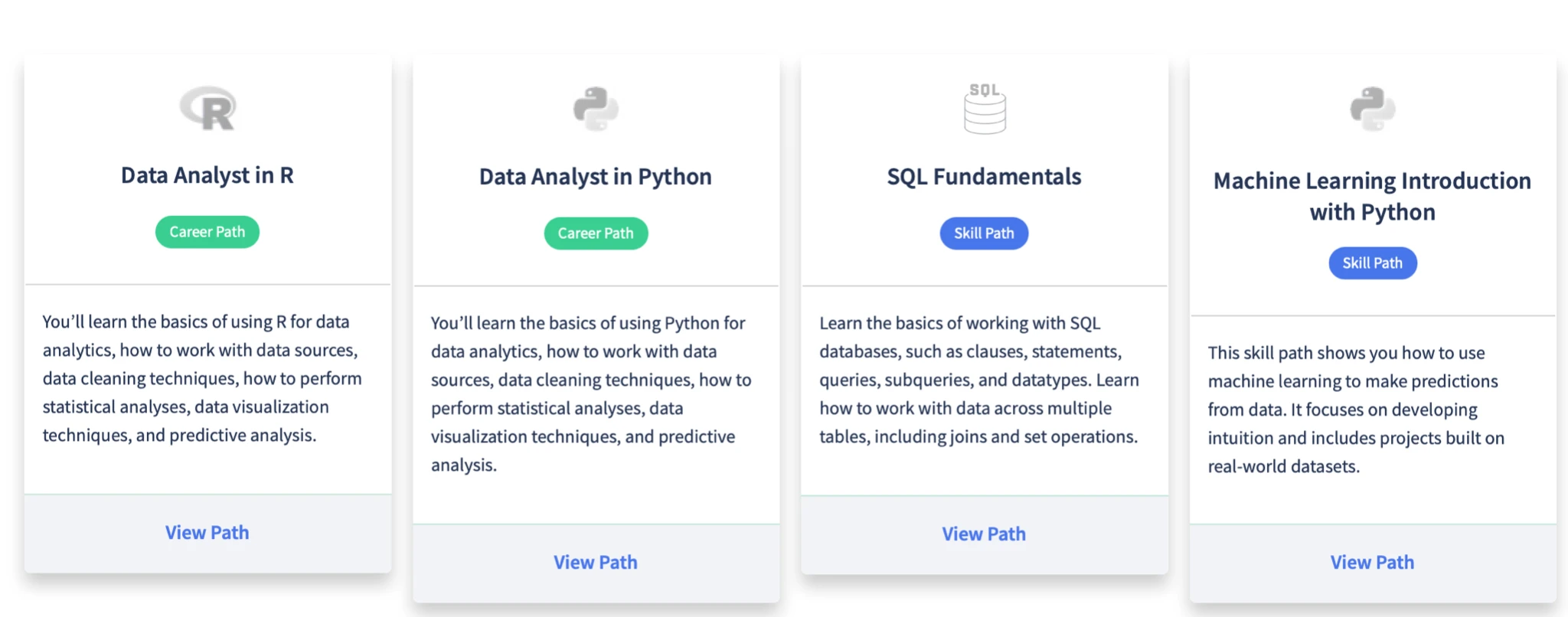
Dataquest’s learning platform is pretty simple to navigate in terms of course offerings. Dataquest offers courses in programming, namely Python and SQL Fundamentals, as well as machine learning.
Other courses are general Data Science courses and include Data Analysis in R, Data Scientist in Python, Data Engineer, and Probability and Statistics. They also have a new Skill Path catalog, which offers the same courses but a way to strategically plan what to take and in what order.
Udacity
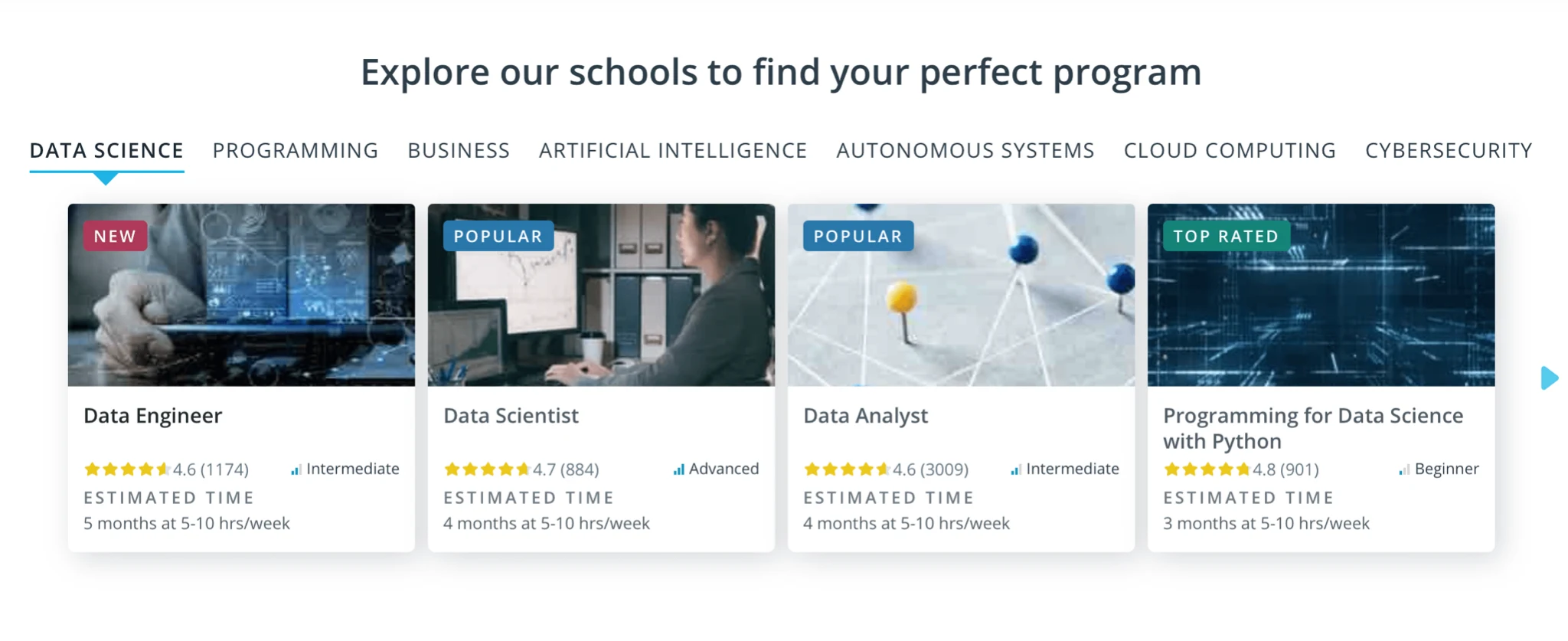
Udacity offers an incredibly expansive course catalog– which can offer more options but also prove more overwhelming, depending on your perspective. Courses outside of Data Science and related material include Artificial Intelligence, Autonomous Systems, other Business (such as product management and monetization), Cloud Computing, Cybersecurity, and free career resources.
Courses are offered in the broad field of Data Science, but also related disciplines.
- Data Science courses: Data Architecture, SQL, Data Analysis, Predictive Analytics, Data Science, Data Engineering, Marketing Analytics, Business Analytics, Programming (Python and R), Data Visualization, Algorithms, Data Streaming, Data Science for Business, and many more.
- Related courses: Machine learning, Deep Learning, Data Structures, multiple courses in AI, Business Analytics, Cloud Computing, and more
My Takeaway
There’s no doubt that Udacity offers a far more comprehensive catalog, but I noticed a lot of overlap for some of the essentials. If you’re just getting started in Data Science, you may find Dataquest sufficient, but for more specific areas, or crossovers more into other fields, Udacity would have to be your pick.
How does the course experience compare to Dataquest vs Udacity?
Finding a course you like is one thing– taking it is another. The learning experience is critical to making your decision, and for me, I always look for easy use, innovative design, and interactive learning.
As someone who has taught college students remotely for the past year, I cannot stress enough just how very important it is to have other means to learn outside of merely watching lectures, especially for business and technology courses.
Dataquest
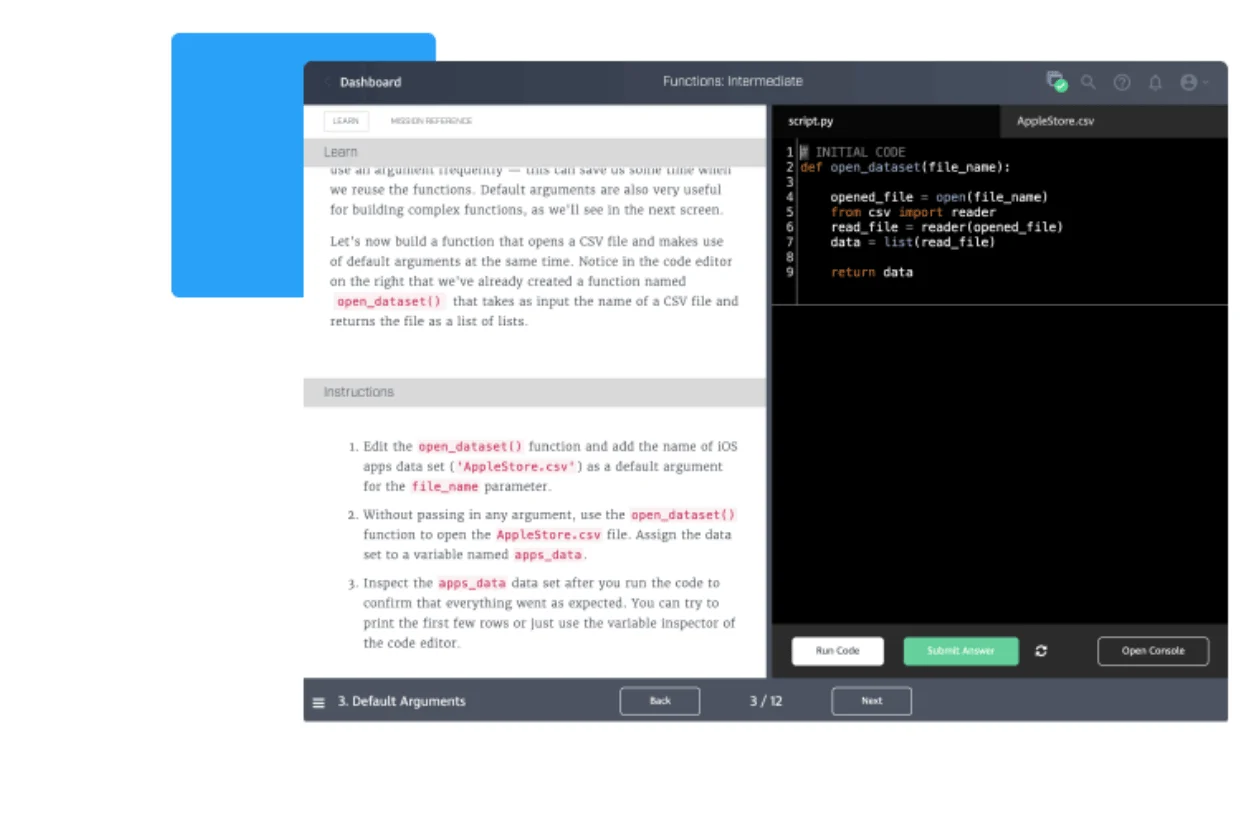
Dataquest courses are all self-paced, with no pressure to finish a course in a certain time period. Within each course, you can also skip to different content sections if you like, through an easy-to-use interface.
Each course includes an introductory text and includes ‘missions,’ or subtopics. This allows you to easily navigate through each topic and even return to the material you didn’t understand.
This also means you can easily finish a bite-size lesson and return later. Guided projects are hands-on projects where you will be tasked with something that is specifically meant to help you apply skills you’ve learned. Within each lesson, you’ll get instant feedback on your code writing through automated grading.
As a whole, the interface is also fairly easy to use– once you get used to it. You have a main dashboard, which helps you keep track of what course you’ve taken, and suggests paths for courses to take next (though you may choose your own, or change your skill path as you’d like). It’ll also provide you with a weekly agenda and notifications.
Keep in mind that lessons are text-based, with a lot of practice on your part, but you won’t be watching videos or working directly with an instructor.
Udacity
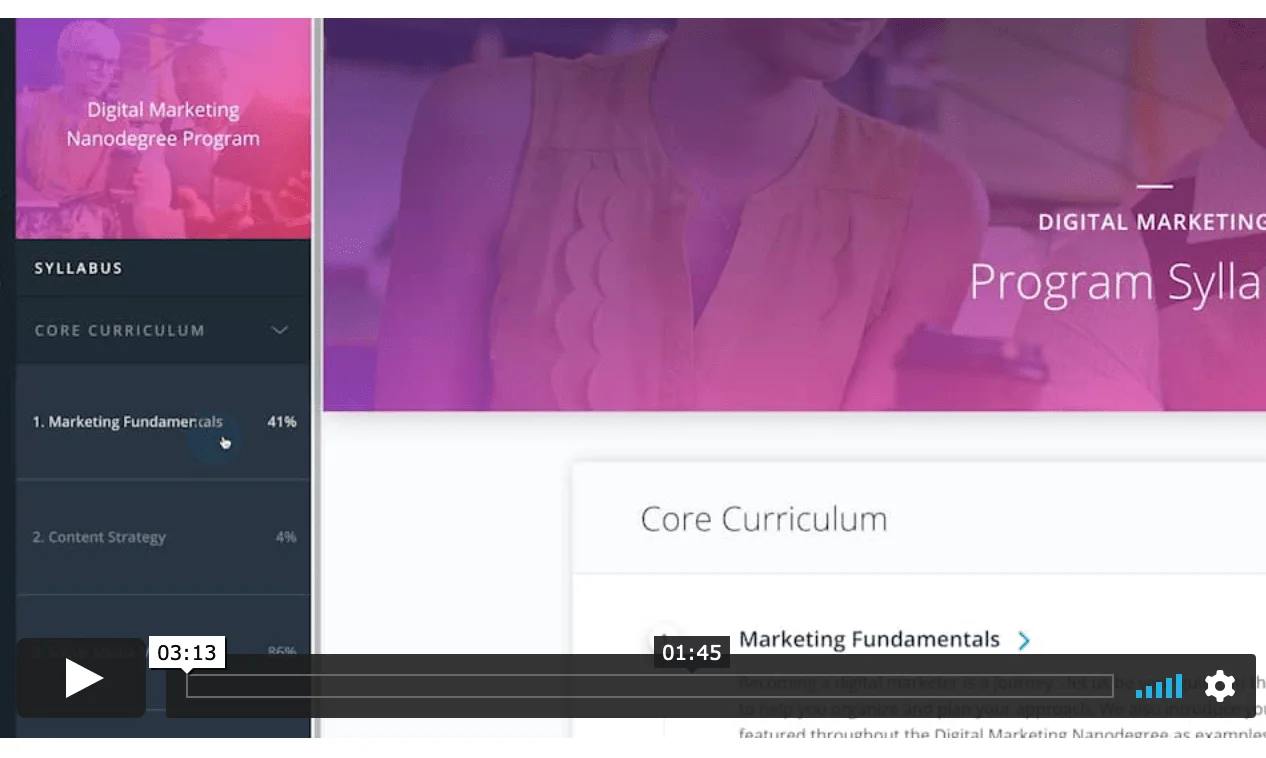
Udacity course also encourages you to learn actively– but in a very different way. All paid Udacity courses include a full course content syllabus and comprehensive sections for different topics within the course. Like Dataquest, they are also self-paced, but I will say you feel more pressured to finish quickly, due to the cost of the program.
The interface is less technical in nature than Dataquest, though still well organized, providing an experience that feels more like a traditional online learning experience. Instead of text-based lessons, you’ll watch video lectures and interviews, which are supplemented with practice questions, quizzes to check your understanding, and mini-projects, as well as capstone projects at the end of larger courses.
While you’re still not working on one with an instructor, the course is led by a specific instructor, who you can find at least a little information about. You may get a little less hands-on practice for coding, but the projects are more innovative and creative, often applying to real-world scenarios.
This might interest you: Best Udacity Nanodegree
My Takeaway
What you like better may come down to a matter of personal preference, and there are pros and cons to the learning experience on Dataquest vs Udacity, but overall I prefer learning on Udacity for most subjects. Udacity provides more room for different types of learning, more creative projects, and varies it up so lessons don’t become too tedious. I also find that these methods make for better retention.
For learning code, of course, you may like the extra practice that Dataquest offers– but the feedback is more or less like taking quizzes, and doesn’t stand out to me as especially interactive or personal.
Frequently Asked Questions
Answer: Udacity does offer free courses, but keep in mind that they tend to be brief and not nearly as in-depth. You also won’t have access to interactive activities, homework, or projects, all of which can be important for learning.
Answer: Dataquest teaches you Data Science skills, with a heavy emphasis on coding. These can be quite useful and may help in an interview, but they are also not equivalent to an official degree or certification, and by no means ensure a job.
Final Decision: Dataquest for Intro; Udacity for the Rest
Udacity and Dataquest both enjoy above-average reviews by other learners and have some great options to offer for Data Science courses. If you just want to study basic coding and introductory courses, save the money and opt for Dataquest. Enroll Here.
That said, Udacity offers far more advanced courses and their learning model is more engaging. If you have a specific course not offered on Dataquest and the budget, consider Udacity. Enroll Here.
While Udacity doesn't have the widest selection, the degrees they DO offer are robust, industry recognized "nano" degree programs (mostly concentrated in TECH careers). If you have the choice - and are looking for recognized credentials - Udacity is the more industry specific pick.
See how Udacity compares to other popular platforms:


